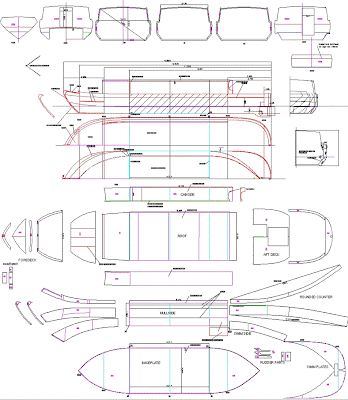There's been no obvious progress on the boat since it was delivered. I have none the less been very busy making preparations. The first thing I needed to do was to get a heavy duty power supply to the boat to supply the welding equipment. I rang the electricity supply company to ask if it was OK to run temporally run my supply on their overhead straining cable that brings in the power to our house. This is not as mad as it sounds as the cables are all heavily insulated. For me this was the safest option, but they re-coiled in horror at the suggestion. It was their opinion that running it across the ground was safer even though cars will drive over it. Oh well they know best!? So I now have a dedicated power cable from the house consumer unit wired into the RCD protected side. Fortunately there was an unused fuse available.
Other things I have been up to this week are sorting out the steel I need to complete the cabin. There are 3 parts for the front that have to be profile cut. The rest of the cabin is made from standard steel stock. Essentially the designer (link below) uses, where possible, standard steel stock sizes, if you like "off the shelf" parts. What he does is design the bow and stern which are the complicated bits. The middle bit of the boat is up to the builder to put in as require to the finished length or customer requirements.
The hatched parts are builder optional
"Profiling" is where the steel sheet is cut with either gas flame, plasma, laser or even water jet all controlled by computer from files supplied by the designer. Not a lot different to cutting a dress from a patten, indeed a paper template could me made for me to cut with a grinder. Its the same process as used by vinyl cut lettering used by sign writers.
Parts I need profile cut.
The small parts are the parts to make the skeg and rudder.
I have also been working on the internal layout. This might seem very premature at the moment but its not. Let me explain. The sides of the cabin can be supplied in one part up to 12m long but this is not cheap to do it this way as there is only one company in the UK that can do this length, also the transport from the Midlands will be expensive too, so the other alternative is to do it in shorter parts that can be folded locally which is relatively competitive due to the sizes involved. Trouble with short lengths is there will need to be joints. Joints will need additional work to minimise their visual impact once the boat is painted. To minimise the the joint area will minimise the "making good". The best way of hiding the joint is to place the windows in the joint area, that way only the small amount above and below the window require additional work.
So to find out where the windows need to go it's necessary to plan the interior. This is the current plan.
Measurements to come.
The blue lines are the windows the red lines are area divisions. The length of the living space is 12.75m
I have to admit the basic plan is someone else's, but its mostly what we want so I have used this as a working example. To make it fit our working area I have had to scale it to 60.4:1 This is accurate to 4mm over the entire length of the boat! A tolerance I can happily work with.
Another thing I have to consider is the roof bracing. As I am going to use 5mm sides these will be self supporting and will not require additional vertical bracing to be welded in. Again any welding to the sides, even inside will cause a ripple so buy using 5mm I can avoid bracing in this area. The roof bracing will be every 500mm centres. The water tank will be bigger than this and therefore needs to be in the body before the bracing goes in. I have been looking at the options for this. The tank will fit under the foredeck, the dark area in the photo below.
.
Space for the fresh water tank.
The considered options so far are, stainless steel, plastic of some sort or an older idea is to use the boat skin to form the tank making an integral tank. The latter would give the largest capacity and the least expensive option but would require the tank the be painted with bitumen every few years so a manhole would need to be incorporated to permit access to do the repaint. Painting the inside of the tank is a sh*t job. I might consider this option but get it GRP'd or have a flexible liner made.
On another note all the rain this week has started to fill up the hull. This is actually going to be useful as the boat is about 99% level at the moment. The water in the bottom is showing it is sitting level down its length, but about 30mm high on the port (left) side . I need to find some jacks to hire to make the fine adjustments and level the boat before welding starts.
I will be speaking with the designer
Nick Branson early next week to pay the licence fee for the CAD files so I can get started with the steel order and so get on with the build.

.jpg)




































